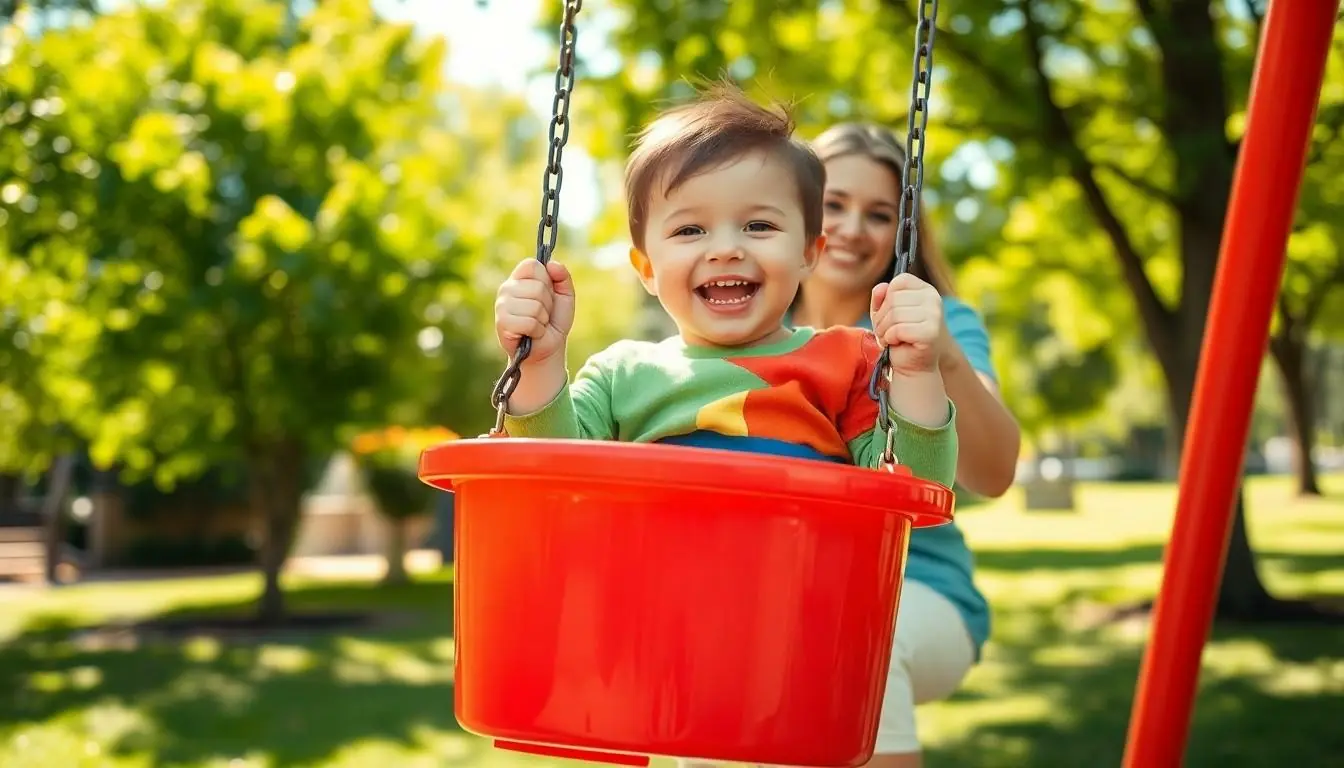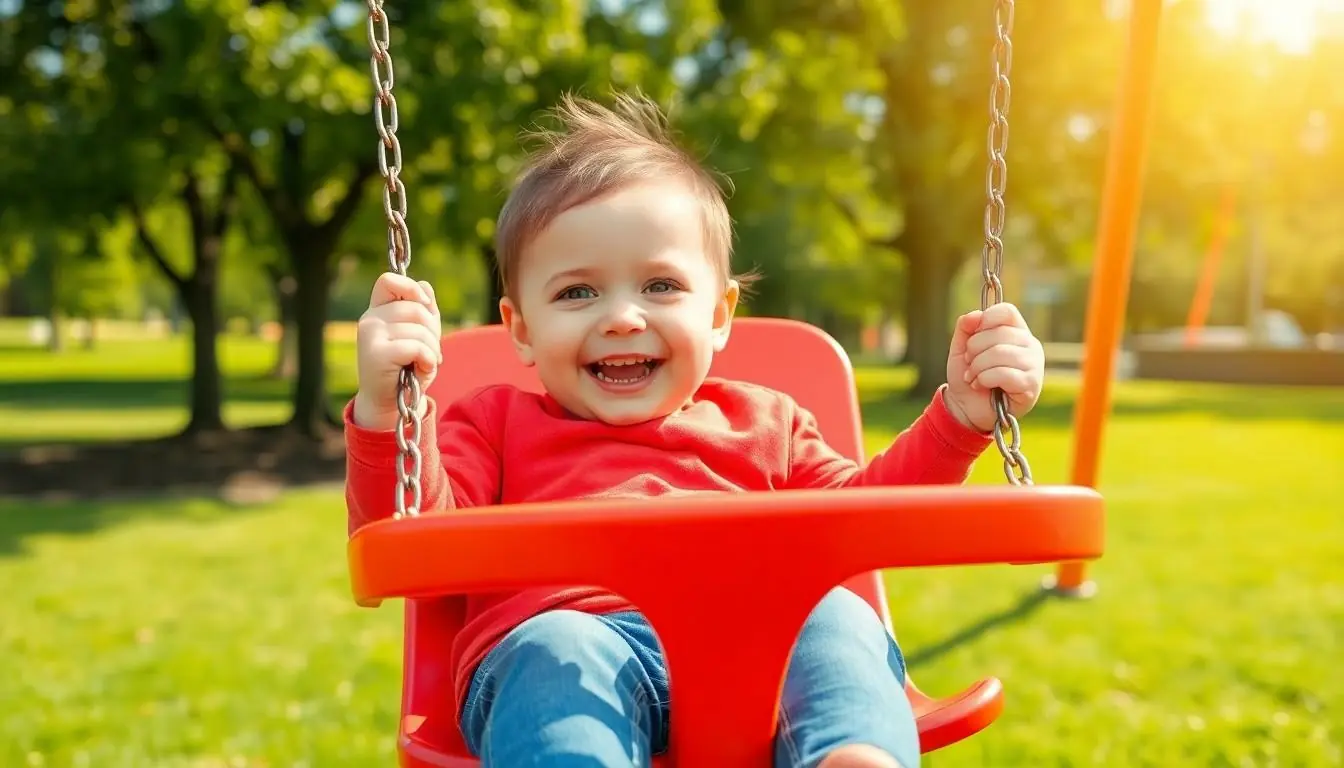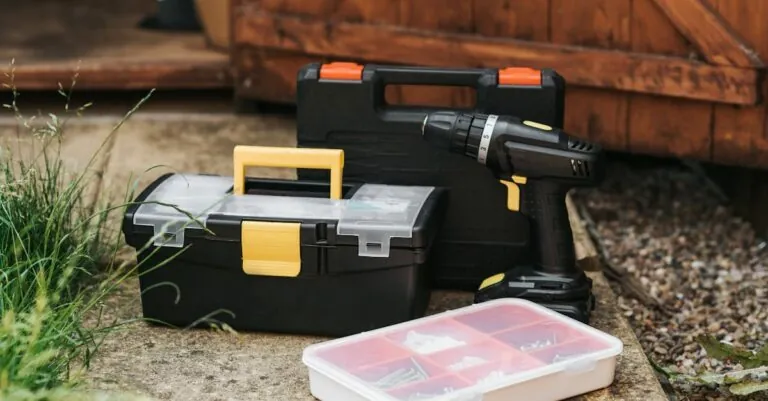Every parent knows the pure joy of watching their little ones swing into the sky, giggling with delight. Swings for toddlers aren’t just toys; they’re magical portals to happiness, where tiny feet take flight and imaginations soar. Who knew that a simple seat and some ropes could unleash such unbridled laughter and excitement?
Table of Contents
ToggleOverview of Swings for Toddlers
Swings designed for toddlers offer numerous benefits, enhancing both physical and emotional development. They promote gross motor skills as children learn to push off and maintain balance during swinging. Safety features in these swings, such as secure harnesses and sturdy frames, ensure that little ones can swing without risk.
Styles of swings vary, including bucket swings, seat swings, and hammock swings. Bucket swings provide a secure, enclosed seating option that helps younger toddlers feel safe. Though they fit smaller children snugly, seat swings offer a more traditional experience, allowing toddlers to swing freely with minimal restraint.
Choosing the right swing involves considering space and age appropriateness. Many swings are designed for specific weight limits, typically ranging from 25 to 75 pounds. Thus, parents should evaluate both safety and their child’s development stage when selecting a swing.
Materials play a crucial role in swing durability and comfort. Most swings utilize weather-resistant plastics or soft fabrics to withstand outdoor conditions while ensuring comfort. Parents often appreciate options that are easy to clean and maintain.
Installation can vary by swing type. Some swings require complete setups with hardware, while others hang from existing playsets or trees. Understanding the mounting options simplifies the process, making it possible for parents to create fun play spaces at home.
Overall, swings for toddlers serve as integral play equipment. They not only deliver joy but also contribute to developmental milestones, fostering a love for outdoor activities.
Types of Swings for Toddlers
Various types of swings cater to toddlers’ needs, safety, and enjoyment. Selecting the right swing can significantly enhance a child’s playtime experience.
Baby Swings
Baby swings provide a secure and cozy option for infants and toddlers. They often feature a bucket design that supports young children safely while swinging. These swings usually come with harnesses or safety straps to prevent falls. Additionally, many models include adjustable recline positions, enhancing comfort during use. Parents often find that baby swings promote sensory stimulation and relaxation, making them ideal for soothing fussy babies.
Outdoor Swings
Outdoor swings allow toddlers to enjoy fresh air and active play. These swings typically include various styles, like traditional belt swings or bucket swings, designed for safety. Swing sets often feature sturdy frames made from metal or wood, ensuring stability during use. Many outdoor swings connect easily to playsets or trees, providing versatility in installation. Engaging in swinging outdoors encourages physical activity and social interaction among children, fostering friendship and cooperation.
Indoor Swings
Indoor swings create a playful space for toddlers within the home. These swings are often compact and can be affixed to door frames or ceilings. Soft materials and padded designs make these swings safe and comfortable for indoor use. Some indoor swing models come with thrilling features like motion or spinning capabilities, adding excitement. Incorporating indoor swings can enhance a child’s imagination and playtime while keeping them active even in limited spaces.
Benefits of Swings for Toddlers
Swings offer significant benefits for toddlers, positively impacting both physical and emotional development.
Physical Development
Swings promote gross motor skills through activities like pushing and pulling. They encourage toddlers to use their muscles, enhancing balance coordination. Engaging with swings builds strength in the legs, core, and arms. As children swing, they experience sensory stimulation which refines spatial awareness. Research shows that such physical activities contribute to healthy growth patterns and foster an early appreciation for outdoor play.
Emotional Development
Swings create an environment for emotional expression and exploration. Enjoying the rhythmic motion often brings joy and relaxation to toddlers. These moments foster independence as children learn to manage their swinging experience. Engaging in play on swings can also boost self-esteem and confidence. Positive interactions from parents and guardians during playtime build strong emotional bonds, nurturing security and happiness in early childhood.
Safety Considerations
Safety plays a crucial role when selecting swings for toddlers. Parents must consider specific guidelines to ensure safe and enjoyable experiences.
Weight Limits
Weight limits vary among different swing models. Manufacturers provide recommended maximum weights, typically ranging between 30 and 75 pounds for toddler swings. It’s essential for parents to consult product specifications. Overloading swings can lead to hazardous situations, increasing the risk of falls or equipment failure. Ensuring toddlers are within the weight capacity maintains safety and prolongs equipment life.
Installation Guidelines
Proper installation remains vital for swing safety. Swings require stable and level surfaces, whether set up in the yard or indoors. Utilize anchors or secure attachments, especially for outdoor swings. Parents should follow manufacturer instructions closely, ensuring all hardware is tight and secure. Inspect swings regularly for wear and tear. Regular checks help identify any potential damage and ensure ongoing safety during playtime.
Popular Brands and Models
Several brands dominate the toddler swing market, each offering unique models tailored for safety and enjoyment. Fisher-Price is recognized for its reliable baby swings, which feature added security through safety harnesses and adjustable reclining positions. Little Tikes presents outdoor swings designed for robust play, incorporating durable materials and vibrant colors to attract toddlers.
Step2 focuses on creating indoor swings that are compact and easy to set up, appealing to families with limited space. Their models often include fun elements like spinning capabilities, enhancing the play experience for young children. Another popular choice, Hape, specializes in wooden swings that prioritize environmental sustainability while ensuring sturdy construction.
In terms of safety, brands like Swing-N-Slide prioritize secure fittings and resist rust, making their outdoor swings a popular choice for long-term use. They also provide clear assembly instructions to guarantee safe setup. On the other hand, the Sharlovy company offers versatile swings that adapt to different stages of a child’s development, accommodating growing toddlers effectively.
Prices for toddler swings vary. Budget-friendly options may range from $30 to $100, while premium models can go up to $200. Buyers can often find useful reviews online or at retail outlets that highlight user experiences with specific brands and models.
When it comes to selecting the right swing, features play a crucial role. Look for safety harnesses, durable materials, and age-appropriate designs to ensure toddlers can play safely. Each brand’s specifications further aid in making informed decisions.
Conclusion
Swings for toddlers offer a delightful blend of fun and developmental benefits. They not only encourage physical activity but also foster emotional growth and creativity. By choosing the right swing, parents can provide a safe environment that enhances their child’s playtime experience.
With various styles available, from bucket swings to indoor options, there’s something for every family. Prioritizing safety features and proper installation ensures that toddlers can swing with joy while minimizing risks. Investing in a quality swing can lead to countless hours of laughter and cherished memories.





